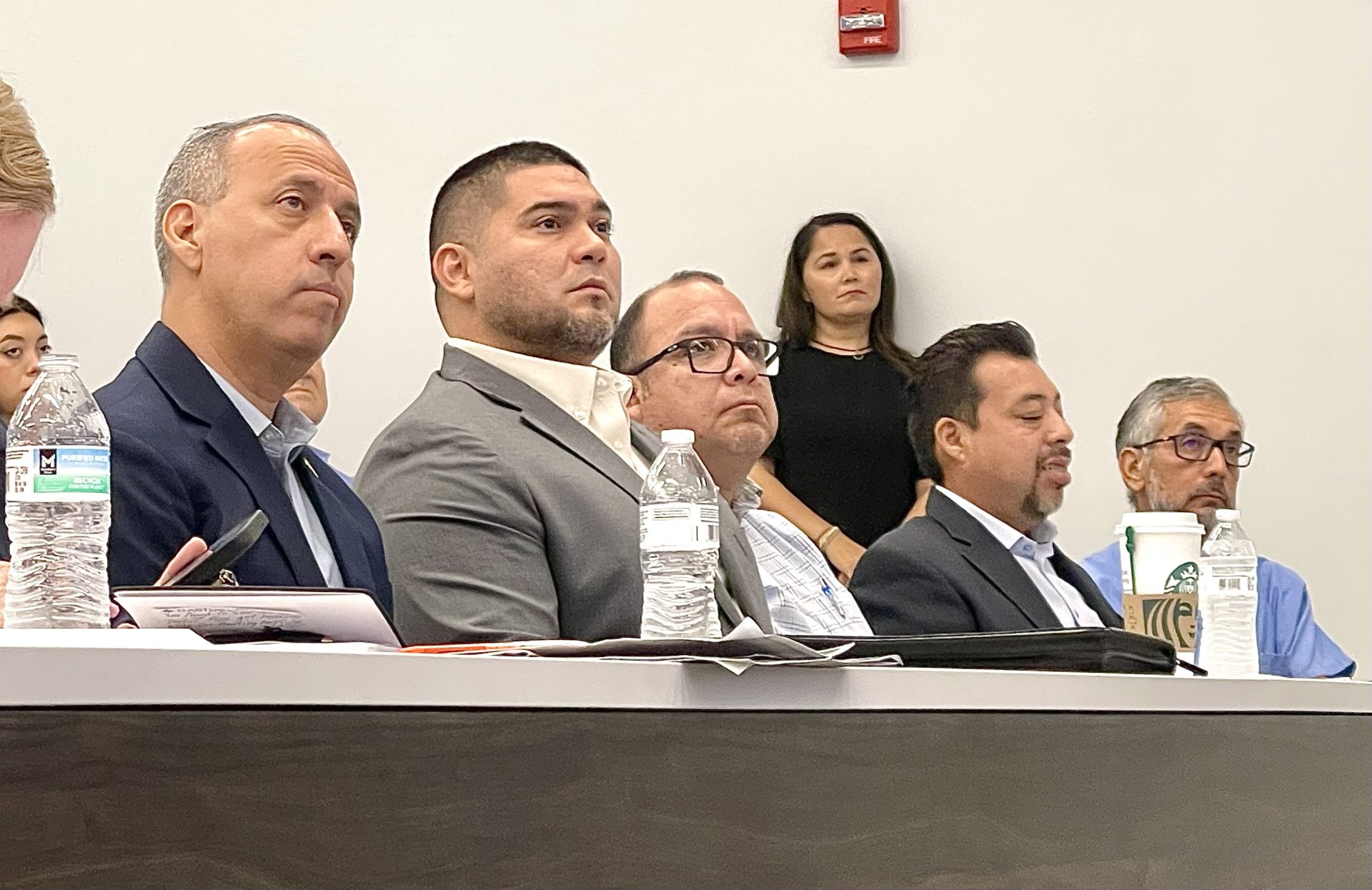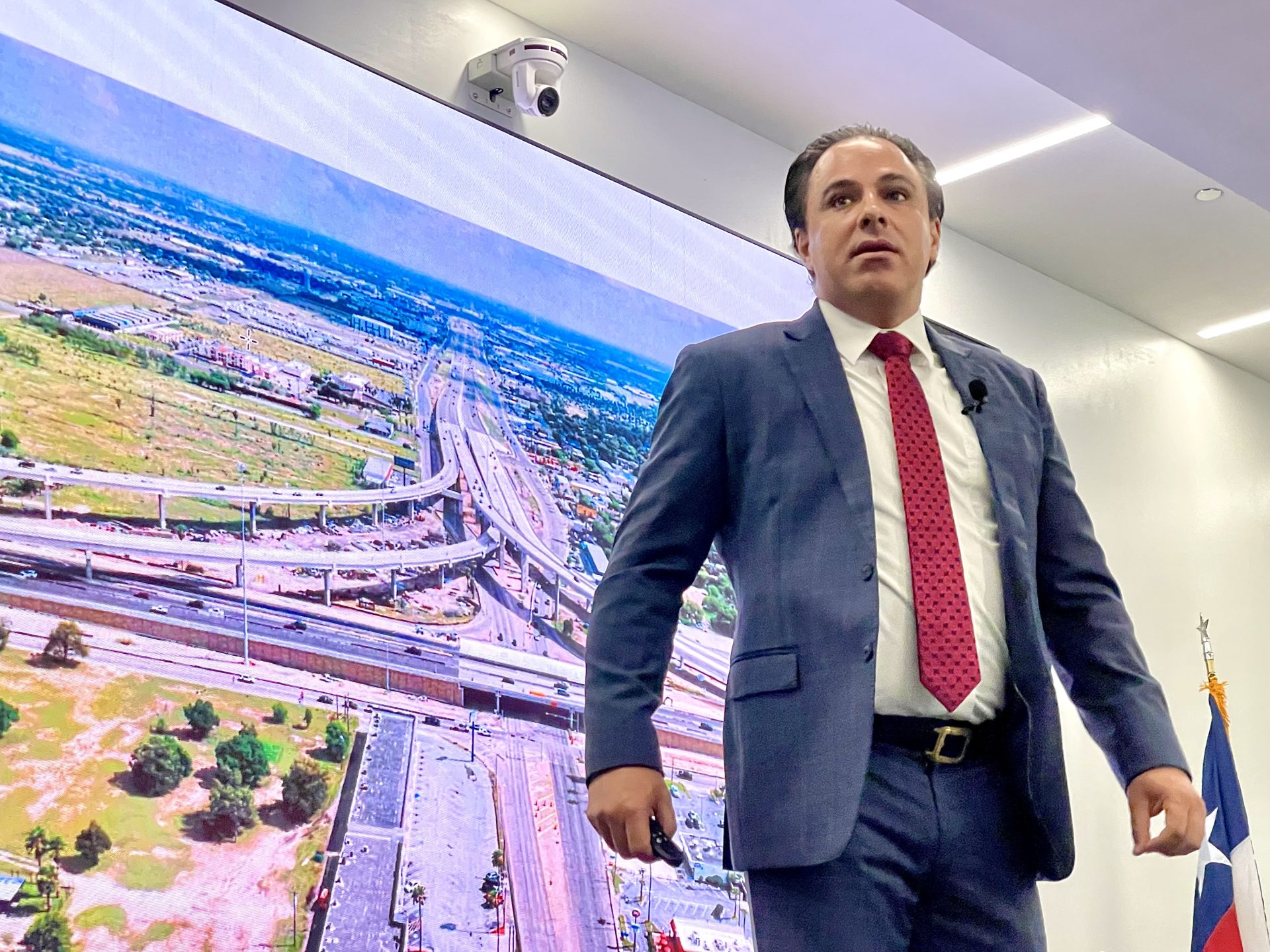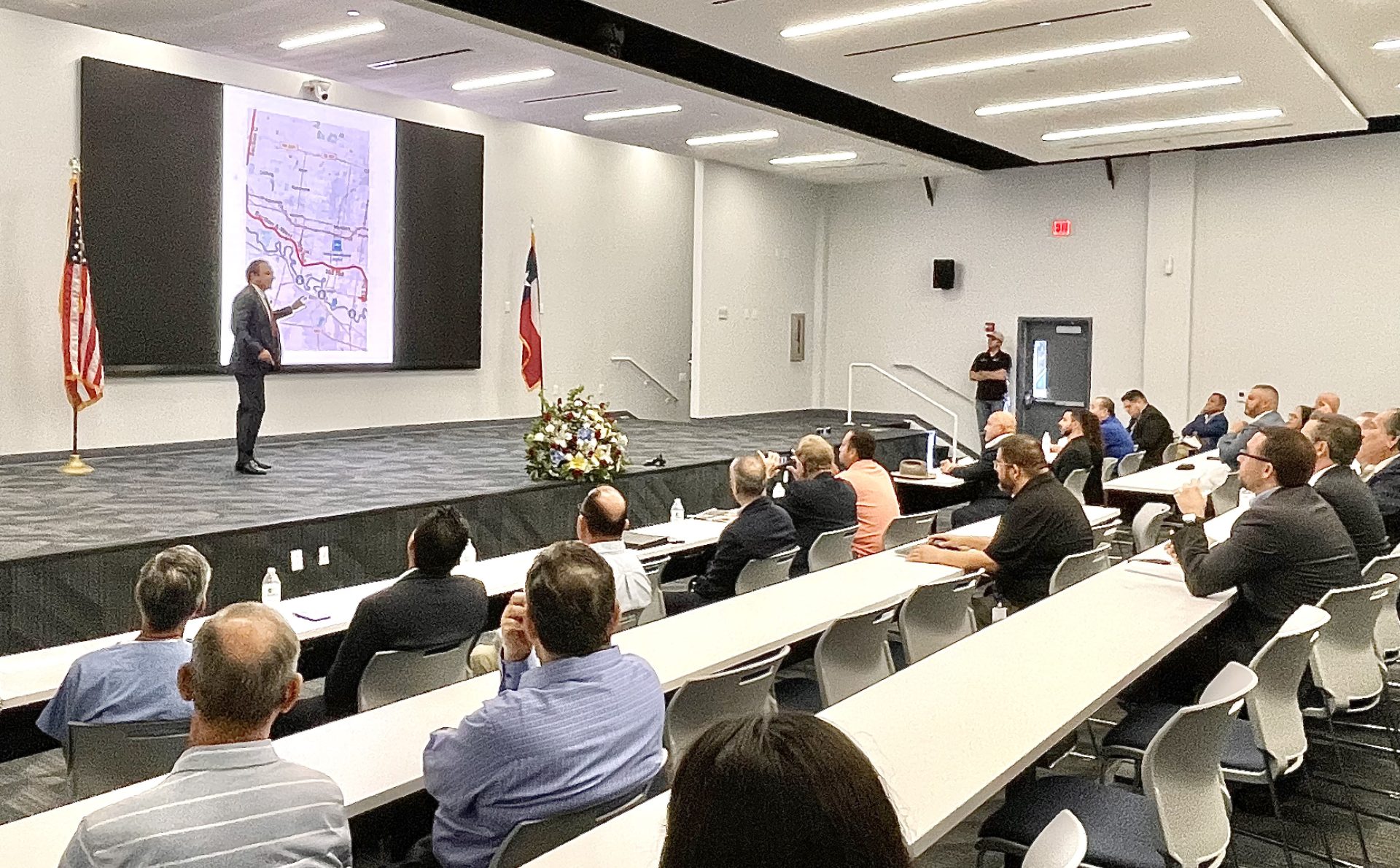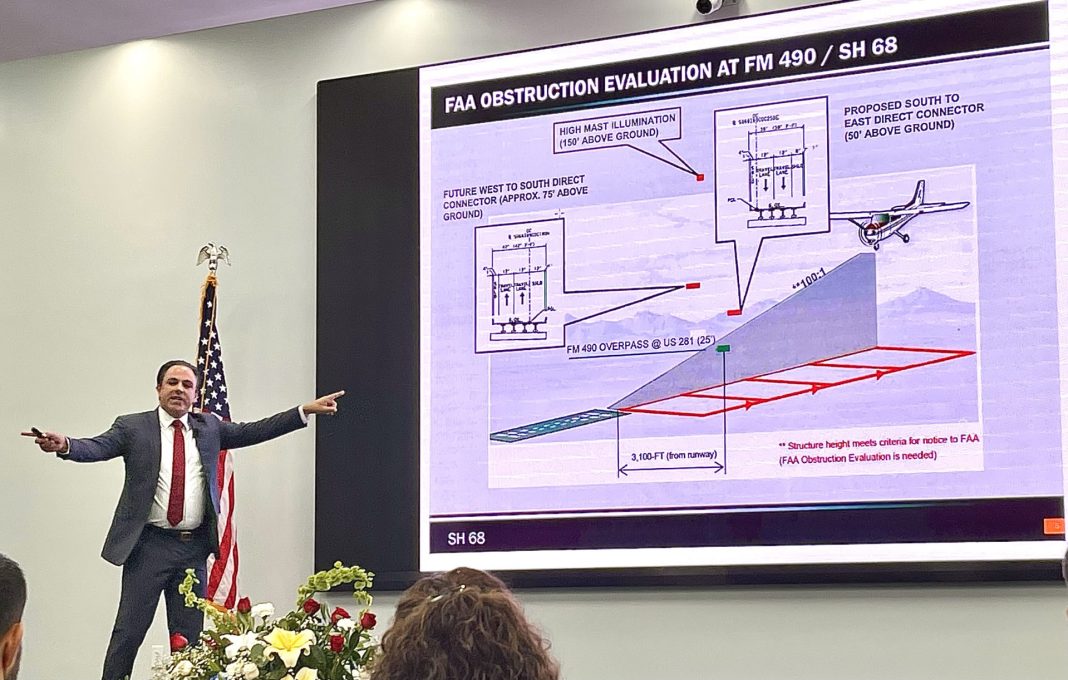|
Only have a minute? Listen instead
Getting your Trinity Audio player ready...
|
PHARR — State Rep. Terry Canales, D-Edinburg, came prepared for a challenge during a meeting at the Pharr ONE center Thursday morning.
Canales says the city of Edinburg — in particular, Mayor Ramiro Garza — and officials at TxDOT are about to make a costly mistake and he wanted local leaders to chime in before it was too late.
Canales invited elected officials from all four Rio Grande Valley counties.
“The reality is these cities that this affects have not weighed in, and that’s why I’m here today,” Canales said.
“Make no mistake, this is my call to action for cities from Brownsville to Starr County and all county officials to look at what’s going to happen,” Canales, an Edinburg native and chair of the Texas House Committee on Transportation, said.
At stake was the location of a connector between the future State Highway 68 and the I-69-C corridor north of Edinburg.
Part of the “International Bridge Trade Corridor,” or IBTC, State Highway 68 will be a 22-mile highway that runs from Interstate 2 near Donna on a northward track parallel to U.S. Highway 281, which is now called Interstate 69-C.
The IBTC corridor is a massive highway project that’s been in the works for over a decade. It’s meant to facilitate commercial truck traffic coming northward from the region’s various international ports of entry and seeking to access the interstate highway system.
Proponents of the multiphase project say it will help relieve traffic congestion on Hidalgo County’s most frequently traveled arterials while also providing an alternate emergency route in the event of a hurricane evacuation order.
But officials in Edinburg are holding the project up, and the highest echelons at the Department of Transportation have been ignoring his requests for more information, Canales said during a fiery presentation before dozens of local leaders.

At issue is something that both Canales and Mayor Garza say they don’t want — an impediment that would slow commercial traffic down and defeat the purpose of the trade corridor.
“We recently learned, in the last six months, from TxDOT, that because the 490 interchange that already exists lies in the direct path of the aviation runway, it can never grow vertically,” Canales said.
The transportation chairman was referring to the current-day intersection of Farm-to-Market Road 490 that lies about 10 miles from the heart of the city.
That rural stretch of land just so happens to be in the flight path of the South Texas International Airport, the city-owned airstrip located just a stone’s throw from the highway intersection.
But therein lies the problem.
The airport’s proximity to the interchange means any future road projects there would be limited to heights that wouldn’t interfere with inbound and outbound air traffic.
TxDOT had wanted to build an interchange with flyovers that would exceed the FAA’s height limitations, Canales said.
As a result, TxDOT’s engineers shifted the proposed connector location north of the airport.
But from the beginning, Edinburg has indicated its desire for the future SH 68 to connect at FM 490, largely because the city hopes to reap the benefits of so much commercial traffic passing by the airport.
That intent was made abundantly clear by his council predecessors going as far back as 2013, the Edinburg mayor said.
“Just like all the international ports of entry, all the cities that are here, we want that same opportunity, the city of Edinburg, to capitalize on this wealth of our region,” Garza said.
The mayor added that city officials were just as surprised as Canales to learn that TxDOT had shifted the alignment of the future connector, and had only learned about it when rural landowners notified Edinburg officials last year.

That’s when city officials began to reach out to TxDOT to not only learn more, but to again stress the city’s desire to construct the SH 68 connector at FM 490.
It wasn’t until more recently that both Edinburg officials and Canales learned of a further hiccup to doing so — the height limitations that would prevent any bridge flyovers at that location would mean that the connector would have to stay on the ground.
And if it stayed on the ground, then the connector would require a traffic light to control — and slow down — SH 68 traffic.
“If we use (490) it will forever be a stoplight,” Canales said.
“That defeats the purpose of the entire corridor,” he added.
From Canales’ perspective, Edinburg is being selfish in continuing to insist that the connector be placed at FM 490.
“It has been the greatest pleasure of my life to work with Ramiro Garza — in fact, I will publicly endorse him for reelection now,” Canales said, referring to the mayor’s reelection campaign, which he announced earlier this summer.
“But we have a big disagreement on this. The city council of Edinburg has passed up this opportunity. They want this, FM 490, and a stoplight,” Canales said.
Garza’s response to Canales’ assignment of blame was measured.
The mayor thanked Canales for his years of work on the transportation committee, and in securing millions in funding not just for Edinburg, but for the Valley as a whole.
The mayor also said Edinburg isn’t interested in slowing commercial traffic down with stoplights, either.
That news had come just as much of a shock to Edinburg officials as it had to Canales, Garza said.
And he blamed that shock squarely on a lack of communication with TxDOT officials — something Canales did, as well.
“They didn’t communicate with us in connection with the new alignment,” Garza said, referring to TxDOT officials stationed at the local district office in Pharr.
The city has had better luck in communicating with TxDOT Executive Director Marc Williams, whom Garza said had recently traveled to Edinburg for a meeting with city officials.

“He stressed to me that, ‘Mayor, we’re gonna figure out what we can do so that the alignment at 490 works for the region,’” Garza said of that meeting.
But Williams hasn’t been as accessible to Canales, whose legislative committee oversees TxDOT funding.
And that had stoked Canales’ ire.
Canales said TxDOT had refused to send a representative to Thursday’s meeting, and was similarly refusing to send one to Edinburg next Tuesday when the city council there will hold a meeting.
“They refused,” Canales said several times with emphasis.
Further, Williams had ignored a letter Canales had sent him on Oct. 15 asking TxDOT to conduct a study on how traffic lights would impact the flow of commerce on the future SH 68.
He also asked for TxDOT to seek input from other Valley cities, in particular, those with international bridges who will most be impacted by any potential commercial traffic bottlenecks.
Incensed, Canales read from a new letter he plans to send to Williams.
“You have neglected to do your job. You have failed the people of South Texas, and therefore you have failed the entire state,” Canales said.
“Your failures are a stain on the agency, and you don’t deserve to lead the men and women of TxDOT. Please be advised that I will be sending you a formal notice asking for your resignation,” he further said.
Late Thursday, officials at TxDOT headquarters in Austin responded to Canales’ statements.
“TxDOT values Texas House Transportation Committee Chair Terry Canales’ passion and commitment to the Rio Grande Valley’s success,” a spokesperson said via email.
“TxDOT will continue to work closely with his office, the Legislature and local partners to ensure the SH 68 project meets the needs of communities,” they further stated.
TxDOT declined to respond to Canales’ call for Director Williams to resign.




